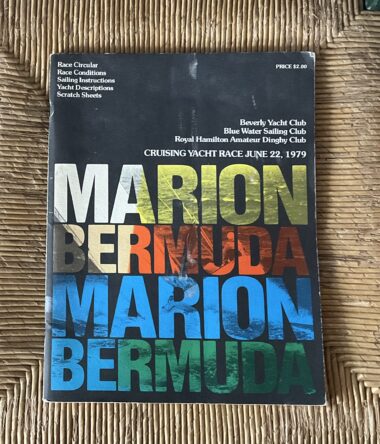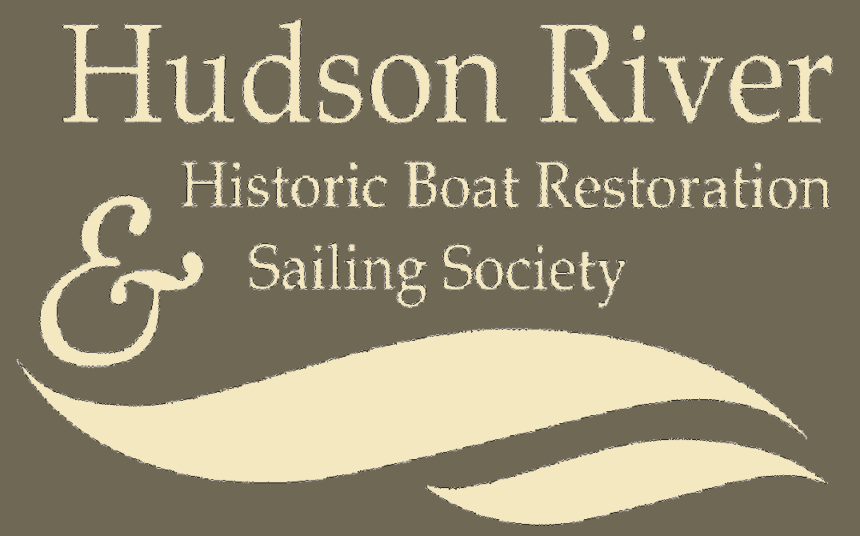Eleanor’s B/log
Share your stories about sailing on the Hudson and boat restoration by contacting us at info@hudsonriverhistoricboat.org and mark them for The B/log. We also welcome comments and questions.
1979 Marion to Bermuda Race
Saturday, February 19, 2022
Recollections of the Navigator
or
Things we shouldnt/a hadnt/a ougtnt/a done
WHOSE IDEA WAS THIS ANYWAY?
For the most part we didn’t do that bad. We finished 99th overall (out of +/- 140), none of us had ever been on an ocean race before, and the weather was terrible. Everything considered it could have been a lot worse.
But it should have been a lot better. We didn’t even beat Abraxas. And for the better part of the trip I was miserable, scared, drunk, or sometimes all three.
It seems to me our problems fell into four general categories:
-
- Inadequate Pre-Race Preparation
- Equipment Failures
- Sailing Technique
- Lack of Ocean Racing Experience
INADEQUATE PRE-RACE PREPARATION
The problems listed here are more or less related to our scheduling of the whole affair. We boarded the boat Tuesday night having only seen it once before the season. We knew or should have known that setting to Marion for the Thursday afternoon check-in might be tight. Yes, we are all trying to lead professional lives on the side to support our sailing habit but if there is to be a next time setting an earlier jump on things might prevent some of the following:
WE GOT OFF LATE — As it was, we had to rush to set off by Wednesday afternoon, and we left some minor things undone. We did not have a full crew until mid-morning Wednesday, and even then BT showed up with some spectators. There were too any goddam things left to be installed. The horseshoe rings, the MOB pole and light mounts, some radio gear, and so on. Another 24 hours would have given us time to do it right – there were times that anyone going overboard would have been in for a long swim. As it was, we barely made it to Marion under the wire, and by then, I, for one was already frazzled.
NO DETAILED INSPECTION OF THE BOAT — Half way to Bermuda one of the port-side shrouds was noticed swinging in the breeze. By the time we got to Bermuda the spinnaker halyard winch was almost overboard and was making nasty noises. Did anyone go over the boat and the rigging? I certainly didn’t. It was blowing pretty hard when we finally noticed the shroud problem. What if we had been on the other tact when the squalls hit? Next time we should even send someone up the stick — remember the jumper-stay on Heffalump that let go one fine morning?
IMPROPER STORAGE OF GEAR –The life-raft damn near came loose: I think it was the same day we discovered the shroud problem. We were in a hurry in New Bedford because of the delays with the motor and waiting for the raft. We should have spent more time and thought to the layout. By the end of the trip the cutaway knife was so rusty I don’t think it could have been used. Which didn’t matter because by then we had no emergency fresh water. Jamming the plastic water jug down into the cockpit locker with the awning gear and all the other crap resulted in a puncture. The only thing we did stow away properly was the dingy (more on that later).
NO MOB DRILLS (OR ANY OTHER KIND) — Before we took off there was all manner of righteous talk about the MOB drills we were going to run on the way to Marion. Had someone really fallen in we might have either lost a crew person or all wound up overboard in the rescue attempt. The closest we came to a drill was a somewhat drunken and highly theoretical argument about correct procedures. Heaving to is not as simple as it sounds and two hours practice in a breeze would have helped prepare us. Also the experience of get trying to get one of the larger crew persons back onboard, even under perfect conditions, would have shown us whether it’s really as difficult as some people say. Even something as simple as everyone taking a reef in the main and the genoa would have assured that (a) everyone did it the same way, and (b) the mainsail reefing lines would have been rigged before the start. But of course we didn’t have time for this.
THE GREAT DRY ICE EXPERIMENT — It sounded great. Freeze all these packages solid as shit in dry ice, and unpack them two at a time so they could cool down the beer as they thawed out. Other people have done it, and it should have worked. Three days out from Marion the dry ice was gone and the food was mostly spoiled. Our fault. When we packed in Lancaster we lined the cooler with dry ice and then added the “pre-frozen” meals we had stored in the garage freezer. But dumping the frozen food on top of the dry ice must have been like pouring in boiling water. The food should have been frozen first, then packed in dry ice two or three days before the start, then repacked with dry ice and sealed the day before the start and delivered to us in Marion. With all those launches around we would have had no problem meeting someone and setting the cooler on board.
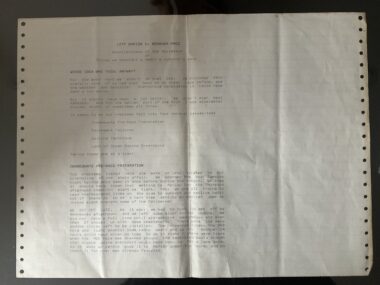
EQUIPMENT FAILURES
There were a surprising number of equipment failures both going and returning. Some we can blame on the weather, some on Peter Costas and his amateur boatyard staff, and some on our own negligence. It could have been worse, since there were at least two dismastings and uncounted other failures in the rest of the fleet, but I suspect the boats experiencing these failures were being sailed pretty hard. With the exception of the centerboard, we didn’t have any problem that threatened the integrity of Poseidon as a sailing vessel, but we had several that threatened our convenience and our safety.
THE ENGINE — First on the charts (log) and last in our hearts. It first died on the way to New Bedford. We were able to set a mechanic to work on it but it’s not clear that he did more than add a missing gasket (thanks again, Peter) and clean the filters. Paul remembers that he found a surprising amount of water in the filter bowl. It did run reliably for another two or three days, but once it got thoroughly wet it was useless. The bilge pump failures may have contributed to the wetting. I’m still amazed that we were able to set it running again. It worked fine in Bermuda and for a while on the way back. It finally succumbed to water in the fuel. It is still not clear where all the water came from. The missing O-ring on the filler pipe plug could not have helped, but we had the rail in the water pretty often on the way down so I would have expected the problem to have appeared in Bermuda, not on the way back. In any case, not having power while becalmed in the Gulf Stream cost us at least one and maybe two days, not having power approaching Block Island cost us some topside paint, and not having power on the way to New London cost the skipper (and ultimately the navigator) the last reserves of humor and psychic energy.
THE BILGE PUMP — Thanks to the beautiful new heat exchanger on the the exhaust system several of the life-preservers in the aft lazarette were burned through and began leaking kapok in the bilge. To worsen the problem, some of our food stores which had been hastily stowed, became soaked with bilge water (of which, given the extreme angle of the heel, they had ample supply), and disintegrated, thereby worsening the pollution problem below. The pump filter finally closed and the pump ran dry for quite some time. We noticed the funny noise too late. Cleaning the filter every twenty seconds or so helped, but I now wonder why we didn’t flood the bilge with the more than plentiful sea water and pump it out with the gusher pump. Surely a couple of cycles would have cleared out most of the gunk. As it was we succeeded only in overloading the already well worn automatic unit. It eventually burned out completely.
THE STEERING — This one we can definitely pin on Peter. He admitted to knowing better than to re-run lag bolts into existing holes but he did it anyway. As a result of this and the heavy strain on the steering gear in the first day of the race, the port side cable pulley came unglued. Good for Paul to have rigged the emergency tiller before things really went to hell. I don’t really see how we could have done anything to prevent this.
THE CENTERBOARD — I’m not sure whose fault this one is but given the amount of time we were on the wind not having a centerboard was rather a nuisance. At first I was one of the people who, while on watch, would try to sneak it down a couple of cranks, but once I heard it banging back and forth I became a believer. Did we ever find out what the problem was?
SAILING TECHNIQUE
We could have sailed the boat better — that’s all there is to it.
SAILING CLOSE-HAULED — There was much more of this than any previous trip and for longer periods of time. Part of the problem was the poor sail selection — it seemed to be very difficult to balance the boat and keep it floating cleanly. Our tacks weren’t that bad but our sail trim was. Subsequent reading (WALLY) convinces me that there were things we could have done to improve our speed and comfort. The day of the start we should have been shortening sail earlier than we did and should have been playing with down-hauls, vangs, and outhauls to set the main in better shape. There is more than personal comfort involved. Living on Poseidon sailing with the rail under is about like climbing a spiral staircase during an earthquake. Dan could have been seriously injured when he got thrown across the cabin, and we all could have used more sleep.
REEFING — We needed more practice and we especially needed to talk things over to find better ways to do it. Clark got his arm smashed trying to reef the main — maybe a couple of practice tries would have taught us all how difficut it is to control the main halyard winch. Reefing the genoa never once took less than 20 minutes with someone leaning over the lifelines on the foredeck trying to feed the reefing line through the grommets. Dropping the sail on the deck would have made the whole operation much simpler and quicker. We should also have procured a number of light lines, the right length and with proper whipping. We should also have had a separate line for bundling the main during the squalls. Practice setting the main down quickly would have made us much more confident about putting it up again.
WEATHER — We finally got our share of it. I had never seen a “white wave” before but, like seeing an Apache in war paint, there is no mistaking the real thing. What scares me is that only the day before I had asked Paul what to do. The next morning, when it was my turn, we could have been in serious trouble. The whole procedure should have been thoroughly discussed ahead of time. It’s no good having one person on the boat who can handle emergencies. With all the experience on the way down, we handled the sail on the way back fairly well. Our mistake here was ignoring the reports of weather ahead from a passing boat and, not giving more heed to the offshore weather forecasts. Wishful thinking on my part convinced me that we had passed the trough hours before the barometer started to drop.
PERSONAL GEAR — Next time, everyone must bring and use a good set of foul weather gear, including boots. The cabin was wet enough from the leaky hatches without us bringing a lot more water below in our clothes. It seemed to me that Clark was the only one who stayed dry.
SEASICKNESS — I honestly don’t know how Dan lived through it. We need more experience with the various remedies and their effectiveness for different people. Mary claims that once she stopped taking the pills she felt fine. I couldn’t survive without them. Having one person sick on a two person watch is dangerous for everyone.
WATCHES — I had never realized just how hard the 12 to 4 can be, especially at night. Four hours of darkness is too much for an amateur crew under the conditions we experienced. The 3-4-5 we used on the way back seemed to be a lot better.
MISC. — The sail would have been easier to manage if we had been using the gusher pump. Having the leeward cockpit locker open with those seas coming aboard made use of the navy pump a real ground loser. I don’t remember who decided that the gusher was broken, but I felt not unlike a fool the next day when Paul “fixed” it with ten quick strokes. We (I) lost the hawse pipe cover because I had never learned the function of the hook on the underside. Even then it might not have been lost if anyone had remembered to stow the anchor chain before we left Bermuda. We also lost one of the blocks used to secure the spinnaker pole to the deck. The block pulled loose on its own but we failed to secure the block itself to the boat.
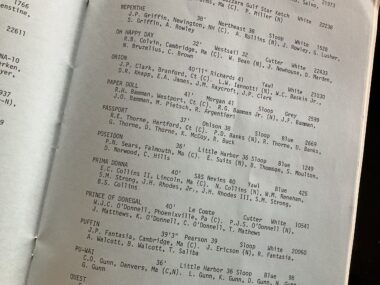
LACK OF RACING EXPERIENCE
Well, everyone has to start somewhere. Still it wold have been nice during the planning of the trip and at the start of the race to have had someone along who had done it before. Spending an afternoon drinking beer with Cap’n Bob might have saved us some grief.
THE DINGHY — Talk about tits on a bull. The dinghy was of no use whatsoever and made the cabintop a terrible place to work. Why didn’t we just leave it behind, or at the worst find an inflatable to borrow or rent. Would the inspector have asked to he see the dinghy had it not been on the cabin. I doubt it.
THE GERRY JUG — I now believe those things were even more of a hazard than we thought at the time. The top leaked and refueling was a mess. Can we consider (for next time) a diesel with a 30 gallon tank to be a non-negotiable demand.
THE MEAL PLAN — The rest of the fleet seems to survive perfectly well on ham sandwiches and cold cereal. Given the difficulties of cooking hot meals under racing conditions I wonder if we couldn’t try to do the same. We could also think about paper plates and unbreakable thermos jugs. Ham sandwiches wash down really well with hot coffee and Kahlua.
NAVIGATION — We didn’t do too badly. In spite of my 90 mile error the last day out from Bermuda we nearly ran over Northeast Shoals buoy. Still, I don’t see how the spirit of a “cruising race” is in any way a violated by Loran-C. Getting penalized four hours for trying to assure a safe passage seems unfair. If we’re going to cheat with the motor we might as well cheat on the navigation, and Loran-C is the best way to do it.
PRE-RACE TUNEUP — I suggest a full two days doing nothing but sailing in circles using every piece of equipment on board. The other big races seem to be preceded by a number of shorter events to get everything shaken down. We should do it on our own.
THE CREW — Having one unhappy person on board is a bit problem. Maybe the skipper and the navigator needed to be more open about decision making so crew members who care about such things wouldn’t feel left out.
*******************
And now for the rest of the story . . .
Recently I rediscovered the Recollections above. I do not know if any of the people who sailed in the race are still alive, but I did reach out to Phyliss, Dan’s girlfriend at the time and later his wife, and we have been having a great deal of fun reminiscing. We both flew down to Bermuda to celebrate their sail. I knew nothing of the trauma until I arrived. Clark flew home with me and a few other crew members and others flew down to help sail Poseidon back.
There was no wind and they floundered around for longer than they wanted and found an unexpected bundle of marijuana floating nearby. They pulled it up and sailed it home but knew they had to get it on shore before they could go through customs.
Dan called Phyliss and asked her to meet the boat at a secluded spot and drive it back to their home in Massachusetts. And she bravely but nervously did. The pot was not very satisfying because it had been waterlogged for who knows how long. But they sold it in $20 bags and people really didn’t complain. The “seaweed” had history.
While they had been sailing lightening hit their home and burned out the stove. The money from the sale of the dope bought a new one.
And it is a story Phyliss and I are now sharing with our children, all of whom will get to know their fathers a little bit better!
We sail too!
Sunday, September 9, 2018
Not all of our members are sailors — yet! Many of our dedicated volunteers who show up regularly on Thursday nights to restore Eleanor are in it for the experience — learning how to put a boat together, enjoying the comradeship of working on the boat, and looking forward to the comradeship of sailing the boat.
But many of our members are. Here are two.
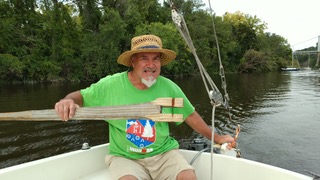
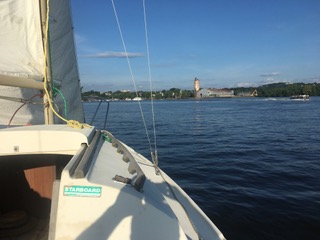
Board and Reconstruction Crew Member Dennis Sailing his First Boat Home
We made it to Hudson about 6:30 last evening just as the tide was turning.
as we made the turn into the Round Out creek on Saturday night. The Power boat club in Kingston
was very hospitable and gave us a spot for the night. I had Jim pick me up, take me to Hudson,
and I fashioned a new tiller from a scrap piece of white oak, and got it installed yesterday (Sunday) morning
and we continued out journey up the river – mostly motoring as the wind was not always favorable and
we needed to get to Hudson before the tide changed and it got dark. . .
Note from the b/logger: Dennis drove up to the restoration site where he knew
he would find everything he needed to make a tiller.
And I’m for Crooked Tilley!
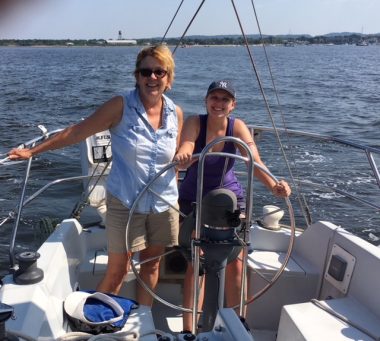
Alice and Phyllis Beals (Board Member) aboard her sailboat Eleanor in Raritan Bay.
“Women sailors are the best!!! Sorry Dennis.” — says President Louise
Note from the b/logger: Guess who she’s named after.
A New Video
Sunday, May 20, 2018
 Click here and scroll to 4:22 for the Eleanor segment
Click here and scroll to 4:22 for the Eleanor segment
And if you haven’t seen Jim Kricker’s video click here.
Ogeemah and the Librarian
Friday, August 11, 2017
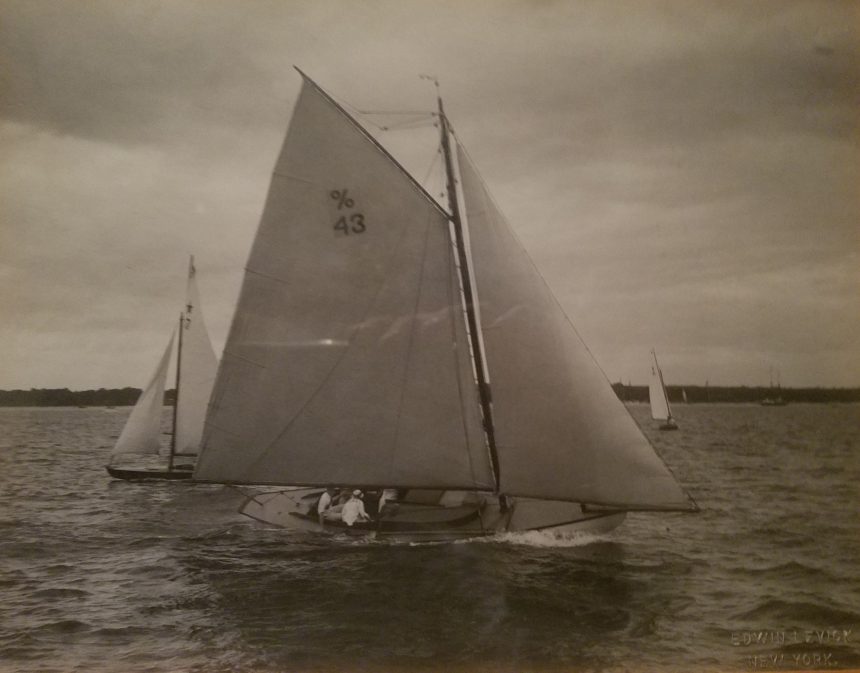
George Dealy, a HRHB member, recently sent us a photo of Ogeemah, his family’s sailboat, built in 1903, the same year as Eleanor, although he didn’t know that at the time. His great grandfather bought her and his grandfather and great uncle sailed her. George has a few trophy cups that she had won and some newspaper clippings. He couldn’t tell us much more.

Top Image — New Rochelle Yacht Club / Won by Ogeemah Sept. 10, 1915
Bottom Image — Handicap Yacht Racing Class Championship 4th Division won by Ogeemah, 1916
I knew there was a story here, and the librarian in me rose to the challenge to unearth and write it. No one needs to know how many research hours went into this project. In fact I finally gave up finding anything pertinent or interesting and started writing. My story was going to be that it was sad that so many of the old beautiful boats have been lost to history and how lucky we are to have the information about the Eleanor that we do have — atho it would be even better if we had more.
But life got in the way and and the story fell from my list of priorities. When it got be at the top of the list again, I started by searching one more time. “That’s how librarians are. They just can’t help it.” (The Boy who was Raised by Librarians, Barbara Morris.)
And there it was. The Library of Congress Chronicling America database led me to an article in, of all places, the Rock Island, Illinois paper, The Argus, May 19, 1906. Here is the article intact.
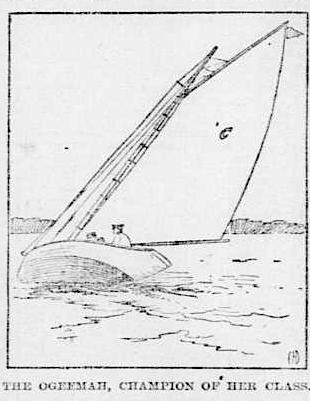 Yachtsmen will be surprised to hear that Alfred Mackay of the Bensonhurst (N.Y.) Yacht club and the New York Canoe club has sold the champion Class Q racer Ogeemah to a member of the Larchmont (N.Y.) club and that the boat has left for its new home on Long Island sound.
Yachtsmen will be surprised to hear that Alfred Mackay of the Bensonhurst (N.Y.) Yacht club and the New York Canoe club has sold the champion Class Q racer Ogeemah to a member of the Larchmont (N.Y.) club and that the boat has left for its new home on Long Island sound.
The boat was designed by John R. Brophy, a well known naval architect and built in 1903 by R. Wallen & Sons. Her dimensions are 30 feet over all, 20 feet load water line, 7 feet 6 inches beam, 5 feet 2 inches draft; with a sail spread of 600 square feet.
The yacht was one of the first boats designed under the displacement rule.
During the first season she sailed at the top of Class P under the old water line length and sail area rule and won the championship of the class in the Gravesend Bay Yacht Racing association.
The boat no doubt will race in Class R, and it is believed by many well informed yachtsmen that there is not a boat of her measurement afloat that can beat her in any kind of weather other than a drifting match.
A. B. Clement was this new owner. His name was already familiar to me from articles on races in Long Island Sound that linked him to Ogeemah. He won quite a few.
John R. Brophy, “the amateur designer from Brooklyn” was chairman of the Atlantic Yacht club regatta committee and had “drawn lines for another in this class (R), and she is exceedingly attractive and should do well. Mr. Brophy designed the Ogeemah, the 22 footer which was the first boat built under the new rule of measurement, and the Ogeemah is still among the crackajacks.” But I found nothing more about him or R. Wallen.
The last of Ogeemah’s races captained by Clements which I discovered was mentioned in the New York Times in September 2012, and the first I discovered captained by “D. E. Dealy” was in May 2014.
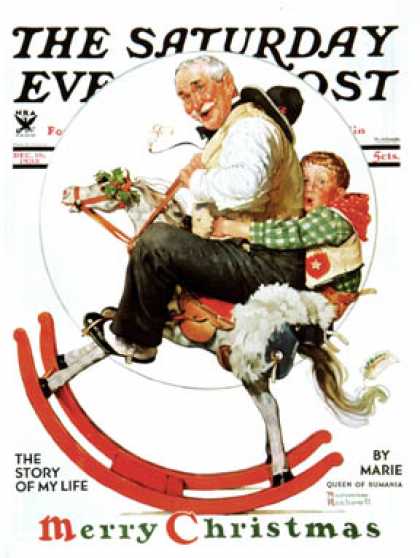
That’s Gramps on the back! — 12/16/1933
According to George, his grandfather Arthur J. Dealy, Sr. “was born right around the turn of the 20th century to a fairly wealthy family in New Rochelle . . . He literally ran away from home to join the U.S. Navy during World War I. He served on a minesweeper in the North Atlantic.” The Dealy’s lived down the street from Norman Rockwell. As best as I can tell, he, and his older brother Ned (Edmund Dealy) were racing Ogeemah before that. The trophies indicate 1915 and 1916 when they would have been teenagers.
Thomas Helprin eventually bought and raced Ogeemah. The first entry I found in the Times mentioning Helprin is in 1924. She was a ferocious little racer and could outrun the larger boats, altho often with a handicap.
However she did have a few mishaps, such as this in Yawl Rissa Wins in Handicap Race:
The fresh southwest wind which greeted the starters caused two accidents and forced two entries to withdraw. T.F. Helprin’s Ogeemah suffered the most damage, her mast being carried away, and she had to be towed by The Walrus which had her halyards carried away in taking the turn around the D2 spar buoy which marked the second leg of the triangular journey of ten miles. — NY Times, 9/2/1928, p. 19.
And she sometimes came in last as in Pontiac Leads in a Mess of Winds. “A. J. Dealey” was the captain.
It was a rather difficult job for the craft of the Handicap Racing Class to pull off their eleventh annual race yesterday afternoon. They finally succeeded, but the light at Execution Rock was twinkling and all the yachts at anchor were showing their riding lights before the Ogeemah limped across the course close to 7 o’clcok last evening before the event became a part of the yachting history of the year. — NY Times, 9/10/1917, p. 17.
My last burst of research effort also solved the mystery of the significance of the name. What or was Ogeemah?
The St. Paul Globe Bookman’s Page published the Passing of Keenoosh-aw Ogeemah, a story by Martin Pollough-Pogue in the November 1901 edition of Outing. Keenoosh-aw Ogeemah is the name of a great shark in this story and perhaps the inspiration of the name of the boat. Ogeemah means King in Ojibway. The Ojibway lived in the Great Lakes area, mostly in Canada but also in the United States.
And where is she now? She seems to have vanished. Although she could be sailing somewhere under another name. I’m sure I will occasionally google her in the future to see what else I can find.
As Molly Harper, still another librarian, said in Nice Girls Don’t Have Fangs:
You can take the girl out of the library,
but you can’t take the neurotic, compulsively curious librarian out of the girl.
JAH
Eleanor’s Solo Sail
Sunday, February 12, 2017
Do you remember Hurricane Floyd?
He passed through the Catskill/Hudson area in September 1999 and caused over
16 million dollars worth of damage in New York alone. The letter below, one of many
written by Louise Bliss to family members, the children of Eleanor’s third captain
Phillip S. Egan, updates them on the journey and expenses generated by Eleanor on
her solo adventure.
There is so little online about Floyd and its effects on the Hudson Valley. If you
have photos, articles, links, or horror stories about sailboat disasters during this
storm, please send them to us in our comments section.
**************
December 3, 1999
Dear Eleanor Owners,
I was feeling that I was late in writing this letter to you, but I see in the files a letter written to all of you on Dec. 3 last year. Interesting is it not, that we are creatures of habit? The pull of the moon and the rise and fall of the tide.
 A busy year for Eleanor. She enjoyed several excellent sails with crew on board, and one sail she decided to go it alone, and a fine job she did. Tired of navigating the river by herself (right in the middle of the channel), she chose the north side of Germantown Landing to end her journey. Not on the rocks, not in the mud, but on nice hard ground. People up and down the river had been on the look out for her and called in her location to Joe Kenneally who I called as soon as I saw from Cesternino’s(1) that she was gone. Horrible!! Horrible! What a terrible thing to experience!! Joe Kenneally, Dean Fisher and I made a trip by boat down the river from the Hudson Power Boat Club to ascertain the damage, if any, and to make certain she would be all right until the change in tide, at which time we could pull her, or float her off the hard ground. Julie, Frank, Joe and I returned that evening to her location, and pulled her off with the help of Jerry from the Power Club in his boat. He even put on a high speed power prop for the job. We pulled her North to the Greendale Landing area and anchored her there for the night. The next morning I returned to Catskill and commandeered three muscle men in a good boat to go over to Greendale and tow her back to Cesternino’s
A busy year for Eleanor. She enjoyed several excellent sails with crew on board, and one sail she decided to go it alone, and a fine job she did. Tired of navigating the river by herself (right in the middle of the channel), she chose the north side of Germantown Landing to end her journey. Not on the rocks, not in the mud, but on nice hard ground. People up and down the river had been on the look out for her and called in her location to Joe Kenneally who I called as soon as I saw from Cesternino’s(1) that she was gone. Horrible!! Horrible! What a terrible thing to experience!! Joe Kenneally, Dean Fisher and I made a trip by boat down the river from the Hudson Power Boat Club to ascertain the damage, if any, and to make certain she would be all right until the change in tide, at which time we could pull her, or float her off the hard ground. Julie, Frank, Joe and I returned that evening to her location, and pulled her off with the help of Jerry from the Power Club in his boat. He even put on a high speed power prop for the job. We pulled her North to the Greendale Landing area and anchored her there for the night. The next morning I returned to Catskill and commandeered three muscle men in a good boat to go over to Greendale and tow her back to Cesternino’s

Samson post
In retrospect, of course, if she had been anchored out at Greendale, all this would have been avoided, but we would have had to leave early on in the afternoon to avoid a run on flood tides. Frank and I checked the lines the evening of the flood and agreed that she would be all right. Little did we, or anyone else know what was to come. She would have been alright had not some powerful dock or boat rammed her, pulling off the cleats, separating the iron rings on the samson post, and actually bending the brass hardware on the standing back stays. The damage to the combing around the cockpit occurred when she hit ground and the boom chock dropped out) later to be recovered by Julie and Joe on the rocks along the shore) which caused the boom to crash down on the combing All in all, it was a stressful time. Thanks to Julie and Frank, Joe, Jerry , Dean, and the three muscle men.
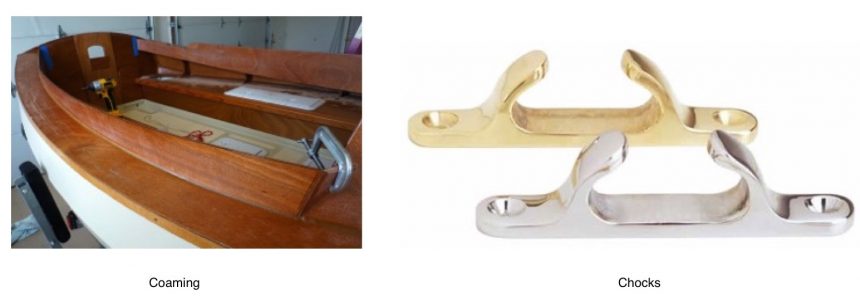 With the help of Mike at Riverview and Jack at Riverview we have a Mr. Glen Neil(4) from Catskill who has agreed to repair the Eleanor. He is very selective in the work he chooses to do, and we are fortunate to have him as our ship’s carpenter. He has watched the Eleanor over the years, and visited with Pop in the spring when Pop would work on the Eleanor, and hs is an old time wooden boat builder.
With the help of Mike at Riverview and Jack at Riverview we have a Mr. Glen Neil(4) from Catskill who has agreed to repair the Eleanor. He is very selective in the work he chooses to do, and we are fortunate to have him as our ship’s carpenter. He has watched the Eleanor over the years, and visited with Pop in the spring when Pop would work on the Eleanor, and hs is an old time wooden boat builder.
He has the o.k. from Mike to work in the yard which is another consideration He is now, after two visits to the Eleanor, in the process of compiling an estimate for the insurance company. We can only take the “wait and see approach.”
On Thanksgiving Day in the morning, Mike, Robert, Frank and Joe covered up the Eleanor. I went over yesterday, and everything looks just fine and snug. Thanks to you all for doing that big job. Of course she has to be checked often to be sure the covers do not blow away, so if you go that way, stop and make a check.
I am enclosing a copy of the statement from Mike for the hauling and blocking. Also, a copy of the check to pay the bill is enclosed. The original figure back in the fall that I sent you was $1008. The present bill is for $1123.20. Or a difference of $115.20. I do not know what I left out, but it is o.k. Phyllis, Mike, Frank and Julie each paid the $114 due from each owner. We are very fortunate that Beth and Bob are holding their interest in the Eleanor for one more year.
Mom has contributed a great deal through out the year too. She continues to pay the insurance premium, and she put the Honda in running order. I used the Honda a lot last spring, and in the fall to haul the canvasses over to Catskill.
During Arts Walk in Hudson Joe found an anchor in one of the stores which he purchased as a gift for the Eleanor. It is a big sea anchor, and replaces the deck anchor which was los in the flood. Joe is a member of the Hudson Power Boat Assoc. and has been a power boater for many years. He understands the river and its habits. He was a good friend to Pop, and now to us.
And now, I am off to pay the bill and to put these letters in the mail.
**********
(1) Mr. Cesternino was the owner of the string of docks that lined the south side of the Catskill Creek for a number of years. While the Eleanor was docked there, he kindly kept an eye on her.
(2) coaming – a vertical surface on a ship designed to deflect or prevent entry of water. It usually refers to a raised section of deck plating around an opening, such as a hatch.
(3) chock – A fitting through which anchor or mooring lines are led. Usually U-shaped to reduce chaf.
(4) Glen Neil was working independently at the time when he repaired the planking on Eleanor.
